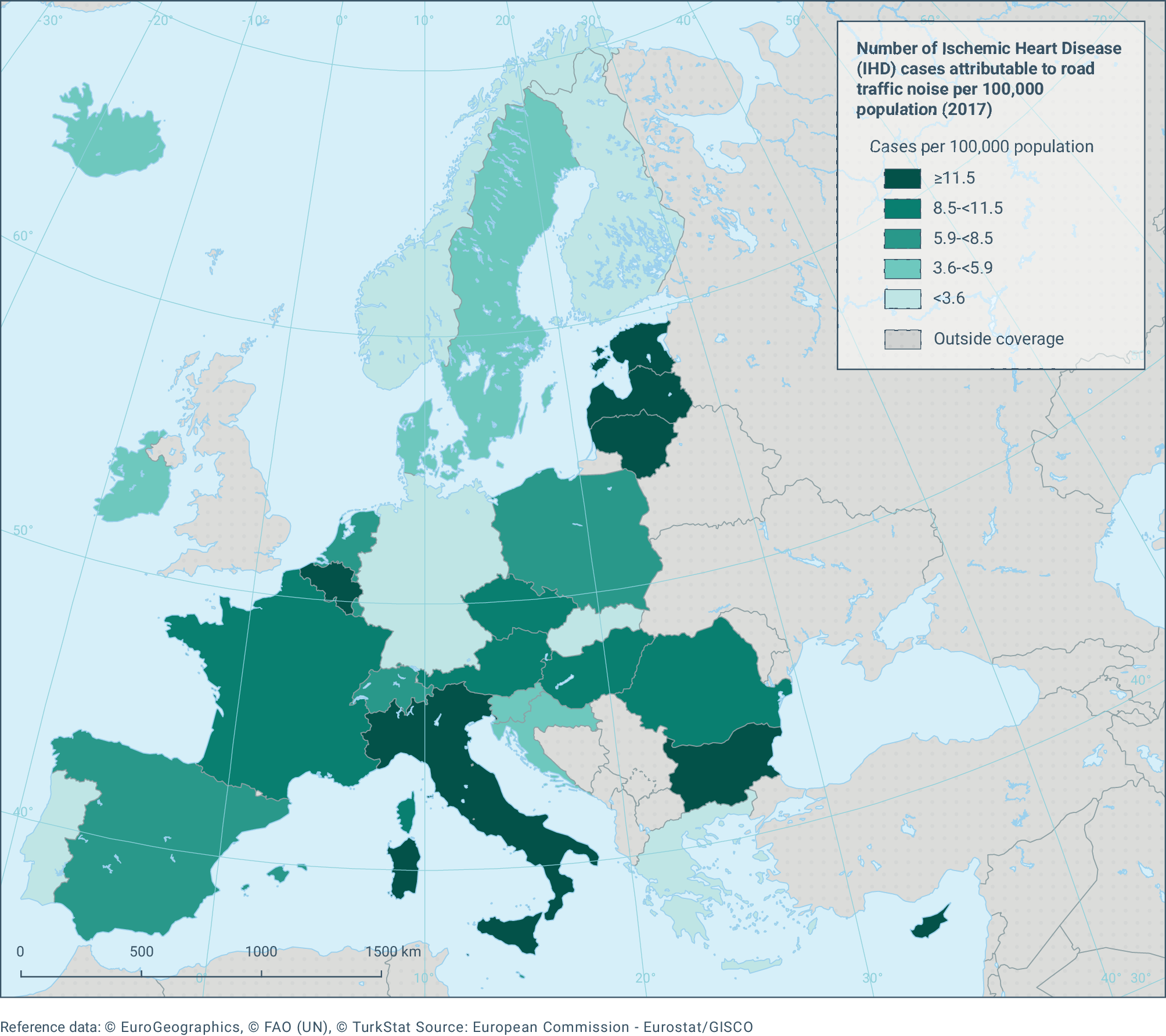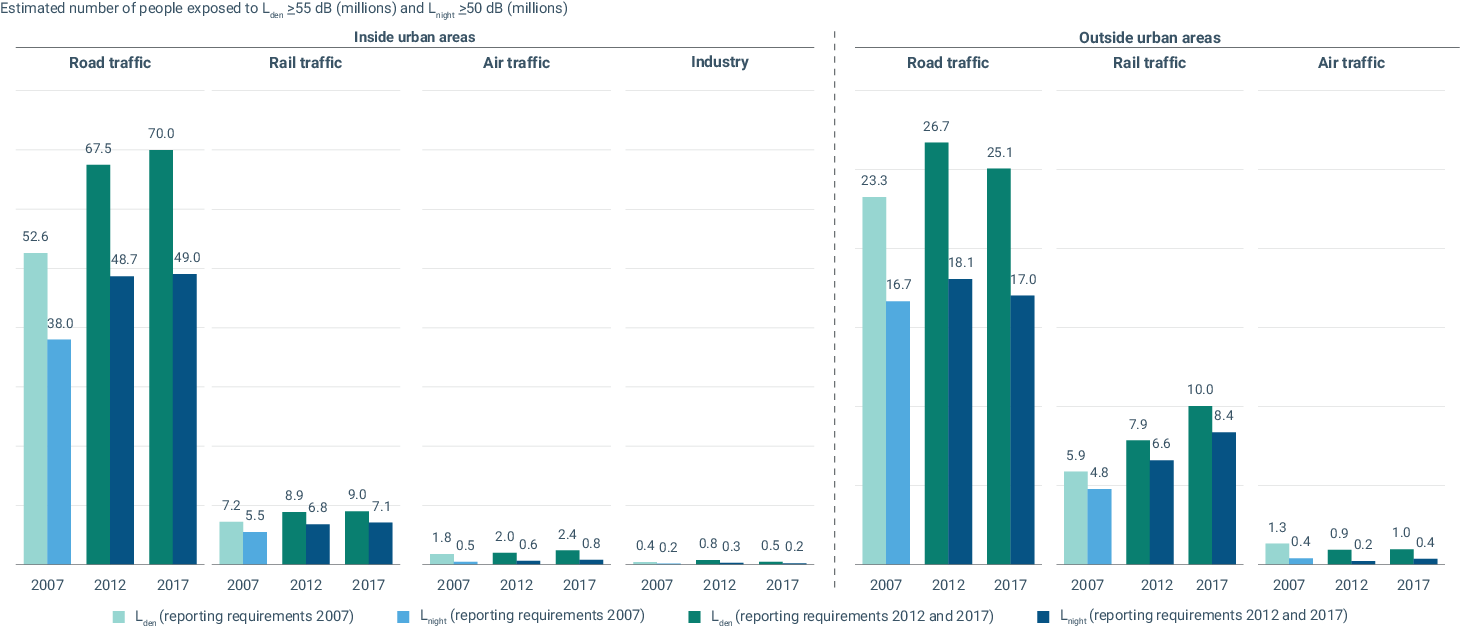Environmental noise and cardiovascular disease
Noise in the environment (and in the workplace — see box 1) increases cardiovascular risk. Environmental noise may induce acute cardiovascular and metabolic effects both directly and indirectly through various pathways of the nervous system. The main effects include the secretion of stress hormones and blood pressure elevations caused by vasoconstriction; these effects occur even during sleep (WHO, 2018). Both stress hormones and blood pressure elevation increase the risk of cardiovascular disease. Harmful noise levels are found not only in busy urban environments but increasingly in other, once natural environments. The main sources of environmental noise are traffic, rail transport, aircraft and industrial activities (WHO Europe, 2018). The best studied type of environmental noise is traffic-related, which has been found to affect the cardiovascular system via stress levels and annoyance, as well as by disrupting sleep (Khosravipour and Khanlari, 2020; WHO, 2018; Kempen et al., 2018; Liu et al., 2022). However, exposure to other noise sources such as aircraft has also been linked to an increased risk of cardiovascular disease (Münzel et al., 2021). Long-term exposure to environmental noise is estimated to cause 12,000 preventable deaths and to contribute to 48,000 new cases of ischemic heart disease per year in the EU (SOER, EEA, 2020).

Source: (EEA, 2021b)
Explore different chart formats and data here
Moreover, environmental noise and other cardiovascular risk factors like air pollution and heat tend to coincide in urban settings, creating hot spots of environmental risks for CVD within cities. These hotspots can be visualised for cities with available data at the EEA’s combined viewer on noise and air pollution.
Trends in exposure to environmental noise in Europe
Environmental noise data are reported to the EU every five years under the Environmental Noise Directive (END). Trends are difficult to establish because of methodology-related comparability issues between the reporting years. However, data suggest that the number of people exposed to levels of noise considered harmful to human health has not significantly decreased across most of the noise sources (Figures 6 and 7). There has even been some increase in railway and aircraft noise outside urban areas during both the day-evening-night and the night-time periods, and for aircraft noise outside urban areas (although this increase is estimated to affect a relatively small number of people).
Source: (EEA, 2021a).
Explore different chart formats and data here
Noise reduction efforts, where implemented, are frequently offset by increased numbers of people, and higher levels of activity and traffic in cities. This is fuelled by continuing migration to urban areas as well as an increased demand for passenger and goods transport across cities, regions and countries (EEA, 2020). The EEA’s Transport noise outlook for 2030 estimates that noise pollution is unlikely to decrease significantly unless strong action is taken to reduce environmental noise. Under a conservative business-as-usual scenario, the number of people affected by noise could even increase by 3%. On the other hand, under an optimistic scenario that includes the implementation of a significant set of ambitious measures, the number of people highly annoyed by transport noise could decline by about 19% by 2030 (Blanes et al., 2022; EEA, 2020).
What the EU is doing about environmental noise
In Europe, the END provides the primary legislative framework for reducing noise. The directive offers a common approach to avoiding and preventing exposure to environmental noise by reporting noise mapping and action planning, thereby reducing its harmful effects and preserving quiet areas. The END tackles environmental noise from major roads, railways, airports and industries, though only in urban areas with populations above 100,000. It sets reporting thresholds of 55dB Lden and 50 dB Lnight, which are well above the WHO recommendations (WHO, 2018). However, there are no binding limits at EU level; the only requirements for countries are monitoring noise and producing noise maps, as well as drawing up action plans in areas where noise levels exceed the thresholds. Accompanying the END, there are a number of specific legislative measures that aim to address or control noise at the source; these include imposing noise limits on certain vehicles or equipment, including their constituting components, or restricting their operation (EEA, 2020). Given the negative impact of noise on human health and the large number of people affected, reducing environmental noise is a key target under the zero pollution action plan, with an aim to reduce the number of people chronically disturbed by noise from transport by 30% by 2030 compared to 2017. A recent report from the European Commission to the European Parliament and Council on the implementation of the END highlights the need for accelerated action in order to meet the targets for environmental noise reduction.
References
Blanes, N., et al., 2022, ETC HE Report 2022/5: Projected health impacts from transportation noise – Exploring two scenarios for 2030, European Topic Centre on Human Health and the Environment (https://www.eionet.europa.eu/etcs/etc-he/products/etc-he-products/etc-he-reports/etc-he-report-2022-5-projected-health-impacts-from-transportation-noise-2013-exploring-two-scenarios-for-2030) accessed 21 April 2023.
EEA, 2020, Environmental noise in Europe — 2020, EEA Report No 22/2019 (https://www.eea.europa.eu/publications/environmental-noise-in-europe) accessed 5 August 2020.
EEA, 2021a, Exposure of Europe’s population to environmental noise, European Environment Agency, Copenhagen, Denmark (https://www.eea.europa.eu/ims/exposure-of-europe2019s-population-to).
EEA, 2021b, Noise data reported under Environmental Noise Directive (END), European Environment Agency, Copenhagen Denmark (https://www.eea.europa.eu/en/datahub/datahubitem-view/c952f520-8d71-42c9-b74c-b7eb002f939b).
Kempen, E. van, et al., 2018, ‘WHO Environmental Noise Guidelines for the European Region: A Systematic Review on Environmental Noise and Cardiovascular and Metabolic Effects: A Summary’, International Journal of Environmental Research and Public Health 15(2), p. 379 (DOI: 10.3390/ijerph15020379).
Khosravipour, M. and Khanlari, P., 2020, ‘The association between road traffic noise and myocardial infarction: A systematic review and meta-analysis’, The Science of the total environment 731, p. 139226 (DOI: 10.1016/j.scitotenv.2020.139226).
Liu, Y., et al., 2022, ‘Noise exposure and risk of myocardial infarction incidence and mortality: a dose-response meta-analysis’, Environmental science and pollution research international 29(31), pp. 46458-46470 (DOI: 10.1007/s11356-022-20377-w).
Münzel, T., et al., 2021, ‘Noise and cardiovascular risk: nighttime aircraft noise acutely triggers cardiovascular death’, European Heart Journal 42(8), pp. 844-846 (DOI: 10.1093/eurheartj/ehaa984).
SOER, 2020, ‘The European environment — state and outlook 2020 — European Environment Agency’ (https://www.eea.europa.eu/soer/publications/soer-2020) accessed 16 September 2022.
WHO, 2018, Biological mechanisms related to cardiovascular and metabolic effects by Environmental noise, (https://www.euro.who.int/__data/assets/pdf_file/0004/378076/review-noise-bio-effects-eng.pdf) accessed 16 September 2021, World Health Organisation.
WHO Europe, 2018, Environmental noise guidelines for the European region, World Health Organization Regional Office for Europe, Copenhagen, Denmark (https://www.euro.who.int/__data/assets/pdf_file/0008/383921/noise-guidelines-eng.pdf) accessed 13 January 2023.


Document Actions
Share with others